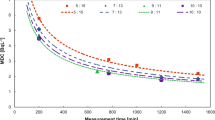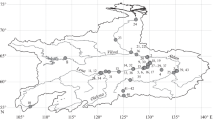Abstract
Tritium activity is determined by standard techniques, in samples collected from fresh, marine and highly saline water around Alexandria. It has been found that, the average 3H activity is 6.32 ±1.17, 4.02±0.77 and 2.90±0.51 Bq.L−1 for West Elnobaria Drain, Lake Marioute and Mediterranean coastal water, respectively. Tritium activity is found to be weakly correlated with water quality parameters; pH, dissolved O2, Oxidation Reduction Potential (ORP), conductivity, salinity and chlorinity. Autocorrelation analysis indicates that the transport phenomena for 3H variations in fresh and saline water are not the same.
Similar content being viewed by others
References
Aly, A. I. M., Nada, A., Awad, M., Salman and Hamza, M. S.: 1988, Isotope Hydrological Investigation of Mohgra and Ain Elsharip Environment, North Western Desert; Egypt; Isotope and Rad. Res. 20, 1, 33–41.
Andersen, A. T. and Foyn, L.: 1969, in Chemical Oceanography, Lange, R. (ed.), Universities forlaget, Oslo, pp. 129–130.
APHA-AWWA-WPCF: 1985, Standard Methods for the examination of water and waste water; American Public Health Association, American Water Workers Association and Water Pollution Control Federation.
Blaylock, B. G., Hoffman, F. O., and Frank, M. L.: 1986, Tritium in the aquatic environment; Radiation Protection Dosimetry; 16 65.
Burton, J. D.: 1975, in Chemical Oceanography; Edited by J. P. Rily and G. Skirrow; Academic Press.
Eisenbud, M.: 1987, Environmental Radioactivity, from Natural Industrial, and Military Sources, 3rd Edition — Academic Press.
IAEA: 1978, International Symposium on behavior of tritium in the environment; San Francisco, CA, 16–20 October, sponsored by IAEA and OECD Nuclear Energy Agency.
IAEA: 1984, pollutants from land-based sources in the Mediterranean. United Nations Environmental Programs Regional Seas Reports and Studies No. 32, prepared in co-operation with, UN/ECE, UNIDO, FAO, UNESCO, WHO and IAEA.
Jordan, C. F., Stewart, M. L. and Kline, J. R.: 1974, Tritium movement in soils: the importance of exchange and high initial dispersion, Health Physics 27, 37–43.
Kamath, P. R.: 1970, The Environmental Radiation Surveillance Laboratory, World Health Organization.
NCRP (National Council on Radiation Protection and Measurements): 1980, Tritium in the Environment; NCRP Report No. 62.
Schell, W. R., Sauzay, G. and Payne, B. K.: 1968, World distribution of environmental tritium in physical behavior of radioactive contaminations in the atmosphere, IAEA.
Sverdrup, H. V., Johnson, M. W. and Flaming, R. H.: 1970, The Oceans, ‘Their Physics, Chemistry and General Biology’, Prentice Hall.
UNESCO: 1987, Technical papers in marine science; International Oceanographic Tables, No. 40, Volume 4.
Author information
Authors and Affiliations
Rights and permissions
About this article
Cite this article
Naim, M.A., Shaker, N., Salem, E.M. et al. Tritium radioactivity in the aquatic environment over Alexandria region, Egypt. Water Air Soil Pollut 73, 275–284 (1994). https://doi.org/10.1007/BF00477992
Received:
Accepted:
Issue Date:
DOI: https://doi.org/10.1007/BF00477992




